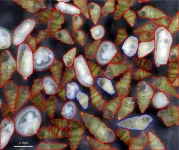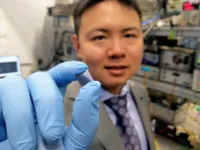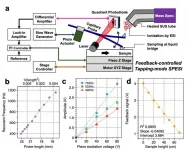INFORMATION:
The paper 'Mass generation, neuron labeling, and 3D imaging of minibrains' by Subashika Govindan, Laura Batti, Samira F. Osterop, Luc Stoppini and Adrien Roux is published in Frontiers in Bioengineering and Biotechnology. DOI: 10.3389/fbioe.2020.582650
https://wysscenter.ch/updates/peeking-inside-mini-brains-could-boost-understanding-of-the-human-brain-in-health-and-disease
About HEPIA
Apart from education and training, one of the missions of the HES (Schools of Applied Sciences) is to conduct applied research projects in conjunction with businesses, cultural institutions and health and welfare organisations, as well as research laboratories in their regions. These projects support technology transfers to economic, industrial and institutional partners.
Applied Research and Development (AR&D) activities at HEPIA are organised into four institutes, covering all the main areas of engineering and architecture, to carry out cross-disciplinary research projects.
Applied research also helps enhance the teaching delivered to students. HEPIA plays a flagship role in the development of innovative solutions and technologies and offers experience in practical projects, paving the way to a wealth of fascinating career prospects.
http://www.hesge.ch/hepia
About the Wyss Center for Bio and Neuroengineering, Geneva, Switzerland
The Wyss Center is an independent, non-profit research and development organization that advances our understanding of the brain to realize therapies and improve lives.
The Wyss Center staff, together with the Center's academic, clinical and industrial collaborators, pursue innovations and new approaches in neurobiology, neuroimaging and neurotechnology.
Wyss Center advances reveal unique insights into the mechanisms underlying the dynamics of the brain and the treatment of disease to accelerate the development of devices and therapies for unmet medical needs.
The Wyss Center was established by a generous donation from the Swiss entrepreneur and philanthropist Hansjörg Wyss in 2014. Additional resources from funding agencies and other sources help the Wyss Center accelerate its mission.
http://www.wysscenter.ch/
MEDIA CONTACT:
Wyss Center
Jo Bowler, Communications Manager
+41 (0) 58 201 03 09
johanna.bowler@wysscenter.ch
HEPIA
Prof. Dr Adrien Roux
adrien.roux@hesge.ch
+41 22 546 25 99
Video
Peeking inside 3D human 'mini-brains' to understand the brain https://youtu.be/TZC-LqtsUSM
Original video files are available to download from the Wyss Center on request.
Image downloads
A seven month old 3D 'mini-brain' imaged with a confocal microscope to reveal the structure of individual neurons throughout.
Image credit: HEPIA
Download 4MB
The Wyss Center's lightsheet microscope
Image credit: Wyss Center
Download 15MB
Peeking inside 'mini-brains' could boost understanding of the human brain
Revealing details of the internal structure of 'mini-brains' could help accelerate drug studies and may offer alternatives to some animal testing
2021-01-07
(Press-News.org) Geneva, Switzerland, 7 January 2021 - 'Mini-brains' are pin-head sized collections of several different types of human brain cell. They are used as a tool, allowing scientists to learn about how the brain develops, study disease and test new medicines. Personalized 'mini-brains' can be grown from stem cells generated from a sample of human hair or skin and could shed light on how brain disease progresses in an individual and how this person may respond to drugs.
Research published today by a team of scientists and engineers from HEPIA and the Wyss Center for Bio and Neuroengineering, in the journal Frontiers in Bioengineering and Biotechnology, has revealed the detailed internal anatomy of 'mini-brains', for the first time.
"Despite advances in growing 'mini-brains', it has been difficult to understand in detail what is going on inside - until now," said Professor Adrien Roux from the Tissue Engineering Laboratory, HEPIA, senior author on the paper.
"Typically, to look inside a 'mini-brain', we slice it thinly and view it on a slide under a microscope. This is a slow process that can damage the sample. Now, for the first time, we have produced high resolution 3D images of single neurons within intact 'mini-brains', revealing their remarkable complexity," added Dr Subashika Govindan, lead author on the paper, who carried out the work at HEPIA and is now Wellcome DBT early career fellow at the Indian Institute of Technology Madras (IITM).
The team combined a novel technique for labeling individual neurons with a method to make the whole sample completely transparent.
Leveraging the Wyss Center's microscopy capabilities, the team developed a state-of-the-art custom module, including a bespoke sample holder and sensitive imaging detectors, for capturing 3D images of entire intact 'mini-brains', without slicing them. They were then able to visualize and analyze the 3D morphology of specific neurons and their anatomical distribution inside the 'mini-brains'.
Dr Laura Batti, Microscopy Facility Manager at the Wyss Center said: "Human 'mini-brains' have a life span of more than a year and, with our new ability to visualize them in more detail, we can envision benefits such as reducing some animal testing."
The new approach could also enable imaging of large numbers of 'mini-brains', making it suitable for high-throughput screening for drug discovery or toxicity testing. It is reproducible and cost-effective and could potentially help accelerate personalized medicine studies.
ELSE PRESS RELEASES FROM THIS DATE:
Faulty metabolism of Parkinson's medication in the brain linked to severe side effects
2021-01-07
Until now, the reason why the drug levodopa (L-Dopa), which reduces the motor symptoms of Parkinson's disease, declines in efficacy after a few years' use has been unknown. A side effect that then often occur is involuntary movements. A Swedish-French collaboration, led from Uppsala University, has now been able to connect the problems with defective metabolism of L-Dopa in the brain. The study is published in Science Advances.
"The findings may lead to new strategies for treating advanced Parkinson's," says Professor Per Andrén of the Department of Pharmaceutical Biosciences at Uppsala University. He and Dr Erwan Bézard of the University of Bordeaux, France, headed ...
Native biodiversity collapse in the Eastern Mediterranean
2021-01-07
The coastline of Israel is one of the warmest areas in the Mediterranean Sea. Here, most marine species have been at the limits of their tolerance to high temperatures for a long time - and now they are already beyond those limits. Global warming has led to an increase in sea temperatures beyond those temperatures that Mediterranean species can sustain. Consequently, many of them are going locally extinct.
Paolo Albano's team quantified this local extinction for marine molluscs, an invertebrate group encompassing snails, clams and mussels. They thoroughly surveyed the Israeli coastline and ...
Low risk of severe COVID-19 in children
2021-01-07
Sweden kept preschools, primary and lower secondary schools open during the spring of 2020. So far, little research has been done on the risk of children being seriously affected by COVID-19 when the schools were open. A study from Karolinska Institutet in Sweden has now shown that one child in 130,000 was treated in an intensive care unit on account of COVID-19 during March-June. The study has been published in New England Journal of Medicine.
So far, more than 80 million people have become ill with COVID-19 and globally, almost two million people have died from the disease. Many countries have closed down parts of society in order to reduce the spread of infection. One such measure has been to close schools. ...
Not just a guys' club: Resistance training benefits older women just as much as older men
2021-01-07
Men and women aged over 50 can reap similar relative benefits from resistance training, a new study led by UNSW Sydney shows.
While men are likely to gain more absolute muscle size, the gains relative to body size are on par to women's.
The findings, recently published in END ...
Vaccine myths on social media can be effectively reduced with credible fact checking
2021-01-07
Social media misinformation can negatively influence people's attitudes about vaccine safety and effectiveness, but credible organizations -- such as research universities and health institutions -- can play a pivotal role in debunking myths with simple tags that link to factual information, University of California, Davis, researchers, suggest in a new study.
Researchers found that fact-check tags located immediately below or near a post can generate more positive attitudes toward vaccines than misinformation alone, and perceived source expertise makes a difference.
"In fact, fact-checking labels ...
Swinburne-led research team demonstrates world's fastest optical neuromorphic processor
2021-01-07
An international team of researchers led by Swinburne University of Technology has demonstrated the world's fastest and most powerful optical neuromorphic processor for artificial intelligence (AI), which operates faster than 10 trillion operations per second (TeraOPs/s) and is capable of processing ultra-large scale data.
Published in the prestigious journal Nature, this breakthrough represents an enormous leap forward for neural networks and neuromorphic processing in general.
Artificial neural networks, a key form of AI, can 'learn' and perform complex operations with wide applications to computer vision, natural language processing, facial recognition, speech translation, ...
Hawai'i drought during El Niño winter? Not always, according to new research
2021-01-07
El Niño events have long been perceived as a driver for low rainfall in the winter and spring in Hawai'i, creating a six-month wet-season drought. However, a recent study by researchers in the University of Hawai'i at Mānoa School of Ocean and Earth Science and Technology (SOEST) revealed the connection between Hawai'i winter rainfall and El Niño is not as straightforward as previously thought.
Studies in the past decade suggested that there are at least two types of El Niño: the Eastern Pacific and Central Pacific, when the warmest pool of water is located in the eastern or central portions of the ocean basin, respectively. El Niño events usually ...
Black people with type 1 diabetes, COVID-19 are four times more likely to be hospitalized for diabetic ketoacidosis
2021-01-07
WASHINGTON--Black and Hispanic people with COVID-19 and diabetes are more likely than Caucasians to die or have serious complications, according to a new study published in the Endocrine Society's Journal of Clinical Endocrinology & Metabolism. ...
'hail to the queen' - saving the Caribbean queen conch
2021-01-07
With an estimated lifespan between 25 to 40 years, the queen conch (Strombus gigas) is a prized delicacy long harvested for food and is revered for its beautiful shell. Second only to the spiny lobster, it is one of the most important benthic fisheries in the Caribbean region. Unfortunately, the species faces a challenge of survival: how to endure and thrive, as populations are in a steady state of decline from overfishing, habitat degradation and hurricane damage. In some places, the conch populations have dwindled so low that the remaining conch cannot find breeding partners. This dire situation is urgent in ecological and economic terms.
To preserve this most significant molluscan fishery in the Caribbean, ...
Want to diagnose brain diseases? A mass spectrometry imaging may one day help you
2021-01-07
Osaka, Japan - Medical professionals all want to be able to quickly and correctly diagnose diseases. Their future ability to do so will depend on identifying what biochemicals are present in tissue sections, where the biomolecules are, and at what concentrations. For this purpose, mass spectrometry imaging--which can identify multiple biochemicals in a single experiment--will be useful. However, the stability of biomolecular sampling needs improvement to obtain the chemical distribution information with high spatial resolution.
In the recent study published in Analytical Chemistry, researchers from Osaka University used mass spectrometry to image the distribution of ...
LAST 30 PRESS RELEASES:
Ants: An untapped resource in the development of antibiotics?
Archaeologists use AI to create prehistoric video game
Mitochondria migrate toward the cell membrane in response to high glucose levels
Tiny viral switch offers hope against drug-resistant bacteria
Most parents aware of early peanut introduction guidelines, but confused about details
HPV vaccine can protect against severe lesions of the vulva and vagina
Virtual care provision and emergency department use among children and youth
Quadrivalent HPV vaccine and high-grade vulvovaginal lesions
Insights into dry eyes gained from stem cell-derived tear glands
Researchers identify 166 human pluripotent stem cell lines available for use in clinical applications
Europa Clipper instrument uniquely observed interstellar comet 3I/ATLAS
UN University Report challenges climate change as sole trigger of Syrian Civil War, exposing governance failures in drought response
Real estate investment trust (REIT) acquisition associated with hospital closure and bankruptcy
New Raman imaging system detects subtle tumor signals
Boston Children’s receives a $7.5 million grant from Aligning Research to Impact Autism (ARIA) to provide clinical research coordination for the IMPACT Network
Spray-on antibacterial coating offers new protection for plants against disease and drought
ESMT Berlin study: What makes a first offer successful in negotiations
Groundbreaking ceremony marks the beginning of CTAO-South Array construction in Chile
Why swearing makes you stronger
What prevents more cancer patients from enrolling in potentially life-saving clinical trials?
UK’s worst-case climate risks laid bare for lawmakers
A decline in churchgoing linked to more deaths of despair
TAMEST announces Maralice Conacci-Sorrell, Ph.D., UT Southwestern Medical Center, as 2026 Mary Beth Maddox Award & Lectureship Recipient
Global study to evaluate whether dengue outbreaks can be anticipated earlier
Chonnam National University researchers propose innovative voltage-loop control for power factor correction
Accelerating next-generation drug discovery with click-based construction of PROTACs
Detecting the hidden magnetism of altermagnets
$7M gift supports health research, engineering and athletics at UT San Antonio
NU-9 halts Alzheimer’s disease in animal model before symptoms begin
Hospitals acquired by real estate investment trusts associated with greater risk of bankruptcy, closure
[Press-News.org] Peeking inside 'mini-brains' could boost understanding of the human brainRevealing details of the internal structure of 'mini-brains' could help accelerate drug studies and may offer alternatives to some animal testing





